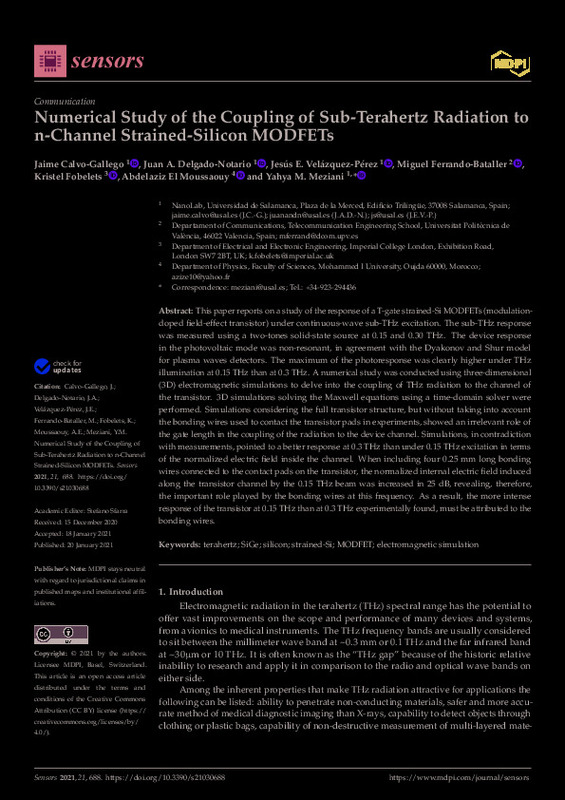JavaScript is disabled for your browser. Some features of this site may not work without it.
Buscar en RiuNet
Listar
Mi cuenta
Estadísticas
Ayuda RiuNet
Admin. UPV
Numerical Study of the Coupling of Sub-Terahertz Radiation to n-Channel Strained-Silicon MODFETs
Mostrar el registro sencillo del ítem
Ficheros en el ítem
| dc.contributor.author | Calvo-Gallego, Jaime
|
es_ES |
| dc.contributor.author | Delgado-Notario, Juan A.
|
es_ES |
| dc.contributor.author | Velázquez-Pérez, Jesús E.
|
es_ES |
| dc.contributor.author | Ferrando Bataller, Miguel
|
es_ES |
| dc.contributor.author | Fobelets, Kristel
|
es_ES |
| dc.contributor.author | El Moussaouy, Abdelaziz
|
es_ES |
| dc.contributor.author | Meziani, Yahya M.
|
es_ES |
| dc.date.accessioned | 2022-06-21T18:04:13Z | |
| dc.date.available | 2022-06-21T18:04:13Z | |
| dc.date.issued | 2021-02 | es_ES |
| dc.identifier.uri | http://hdl.handle.net/10251/183530 | |
| dc.description.abstract | [EN] This paper reports on a study of the response of a T-gate strained-Si MODFETs (modulation-doped field-effect transistor) under continuous-wave sub-THz excitation. The sub-THz response was measured using a two-tones solid-state source at 0.15 and 0.30 THz. The device response in the photovoltaic mode was non-resonant, in agreement with the Dyakonov and Shur model for plasma waves detectors. The maximum of the photoresponse was clearly higher under THz illumination at 0.15 THz than at 0.3 THz. A numerical study was conducted using three-dimensional (3D) electromagnetic simulations to delve into the coupling of THz radiation to the channel of the transistor. 3D simulations solving the Maxwell equations using a time-domain solver were performed. Simulations considering the full transistor structure, but without taking into account the bonding wires used to contact the transistor pads in experiments, showed an irrelevant role of the gate length in the coupling of the radiation to the device channel. Simulations, in contradiction with measurements, pointed to a better response at 0.3 THz than under 0.15 THz excitation in terms of the normalized electric field inside the channel. When including four 0.25 mm long bonding wires connected to the contact pads on the transistor, the normalized internal electric field induced along the transistor channel by the 0.15 THz beam was increased in 25 dB, revealing, therefore, the important role played by the bonding wires at this frequency. As a result, the more intense response of the transistor at 0.15 THz than at 0.3 THz experimentally found, must be attributed to the bonding wires. | es_ES |
| dc.description.sponsorship | This research was funded by the Ministerio de Ciencia, Investigacion y Universidades of Spain (Spanish Ministry of Science, Innovation, and Universities) and FEDER (ERDF: European Regional Development Fund) under the Research Grants numbers RTI2018-097180-B-100, PID2019-107885GB-C3-2 and TEC2016-78028-C3-3-P and FEDER/Junta de Castilla y Leon Research Grant numbers SA256P18 and SA121P20. Also by Conselleria d'Educacio, lnvestigacio, Cultura i Esport, Generalitat Valenciana (Spain) through the grant AIC0/2019/018. The APC was funded by Universidad de Salamanca. | es_ES |
| dc.language | Inglés | es_ES |
| dc.publisher | MDPI AG | es_ES |
| dc.relation.ispartof | Sensors | es_ES |
| dc.rights | Reconocimiento (by) | es_ES |
| dc.subject | Terahertz | es_ES |
| dc.subject | SiGe | es_ES |
| dc.subject | Silicon | es_ES |
| dc.subject | Strained-Si | es_ES |
| dc.subject | MODFET | es_ES |
| dc.subject | Electromagnetic simulation | es_ES |
| dc.subject.classification | TEORIA DE LA SEÑAL Y COMUNICACIONES | es_ES |
| dc.title | Numerical Study of the Coupling of Sub-Terahertz Radiation to n-Channel Strained-Silicon MODFETs | es_ES |
| dc.type | Artículo | es_ES |
| dc.identifier.doi | 10.3390/s21030688 | es_ES |
| dc.relation.projectID | info:eu-repo/grantAgreement/AEI/Plan Estatal de Investigación Científica y Técnica y de Innovación 2017-2020/PID2019-107885GB-C32/ES/ANTENAS X-WAVE MULTIMODO Y MULTIHAZ RECONFIGURABLES PARA SISTEMAS DE COMUNICACIONES Y SENSORES/ | es_ES |
| dc.relation.projectID | info:eu-repo/grantAgreement/JCYL//SA121P20/ | es_ES |
| dc.relation.projectID | info:eu-repo/grantAgreement/AEI/Plan Estatal de Investigación Científica y Técnica y de Innovación 2017-2020/RTI2018-097180-B-I00/ES/NUEVA GENERACION DE TRANSISTORES FET PARA TECNOLOGIA DE THZ/ | es_ES |
| dc.relation.projectID | info:eu-repo/grantAgreement/MICINN//TEC2016-78028-C3-3-P//Diseño de antenas multihaz de alta ganancia para los sistemas de comunicaciones de nueva generación/ | es_ES |
| dc.relation.projectID | info:eu-repo/grantAgreement/AEI//RTI2018-097180-B-I00//NUEVA GENERACION DE TRANSISTORES FET PARA TECNOLOGIA DE THZ/ | es_ES |
| dc.relation.projectID | info:eu-repo/grantAgreement/JCYL//SA256P18/ | es_ES |
| dc.relation.projectID | info:eu-repo/grantAgreement/GVA//AICO%2F2019%2F018/ | es_ES |
| dc.rights.accessRights | Abierto | es_ES |
| dc.contributor.affiliation | Universitat Politècnica de València. Departamento de Comunicaciones - Departament de Comunicacions | es_ES |
| dc.description.bibliographicCitation | Calvo-Gallego, J.; Delgado-Notario, JA.; Velázquez-Pérez, JE.; Ferrando Bataller, M.; Fobelets, K.; El Moussaouy, A.; Meziani, YM. (2021). Numerical Study of the Coupling of Sub-Terahertz Radiation to n-Channel Strained-Silicon MODFETs. Sensors. 21(3):1-11. https://doi.org/10.3390/s21030688 | es_ES |
| dc.description.accrualMethod | S | es_ES |
| dc.relation.publisherversion | https://doi.org/10.3390/s21030688 | es_ES |
| dc.description.upvformatpinicio | 1 | es_ES |
| dc.description.upvformatpfin | 11 | es_ES |
| dc.type.version | info:eu-repo/semantics/publishedVersion | es_ES |
| dc.description.volume | 21 | es_ES |
| dc.description.issue | 3 | es_ES |
| dc.identifier.eissn | 1424-8220 | es_ES |
| dc.identifier.pmid | 33498386 | es_ES |
| dc.identifier.pmcid | PMC7864021 | es_ES |
| dc.relation.pasarela | S\454565 | es_ES |
| dc.contributor.funder | Generalitat Valenciana | es_ES |
| dc.contributor.funder | Universidad de Salamanca | es_ES |
| dc.contributor.funder | Junta de Castilla y León | es_ES |
| dc.contributor.funder | AGENCIA ESTATAL DE INVESTIGACION | es_ES |
| dc.contributor.funder | Agencia Estatal de Investigación | es_ES |
| dc.contributor.funder | European Regional Development Fund | es_ES |
| dc.contributor.funder | Ministerio de Ciencia e Innovación | es_ES |








